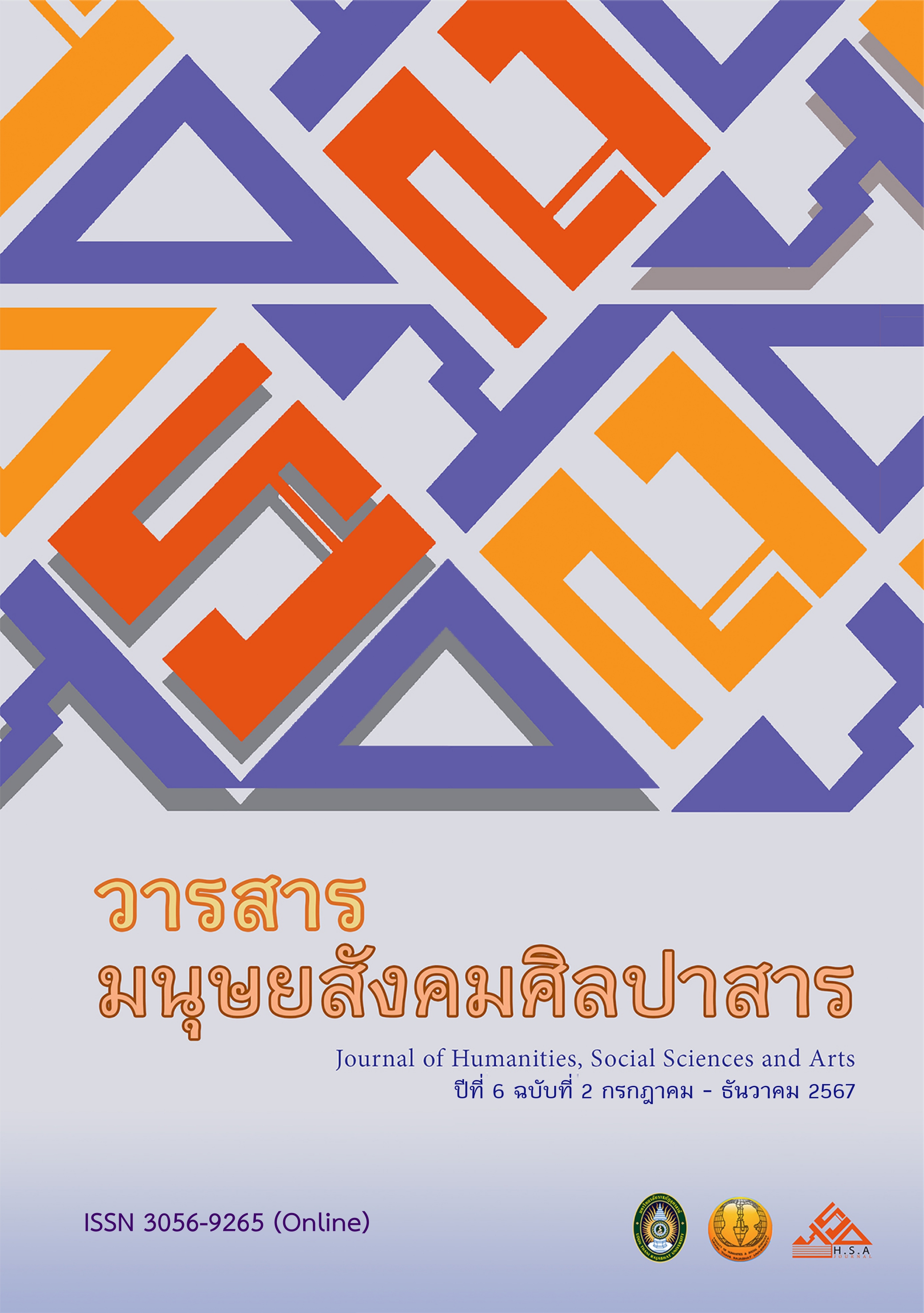THE CREATIVE DANCE WORK “AE-AONG ANONGNAT RATCHA MATSRI”
Main Article Content
Abstract
This creative performing arts work aims to provide an understanding of the literature of the Mahavesandorn Jataka and to use it as a foundation for creating a dance performance titled “Ae-Aong Anongnart Ratcha Matsri.” The creator has chosen the 13th chapter, Nakhon Khand, specifically the part where Queen Phusadee presents adornments (Ae), to convey the dance movements in the form of a creatively crafted folk-dance performance, gathering information from books, manuals, research works, theses, and research articles.
From the gathered information, the creators have recognized the significance of Princess Matree, who exhibited delicacy in every gesture, including bathing and dressing, before returning to Si Phin City. A total of 21 performers were involved, consisting of 7 male actors and 14 female actors. The costumes were inspired by the attire of the Isan people and the paintings (Huup Taem) found on the walls of the ordination hall (Sim Isan), combined with the imagination of the creators. The jewelry was selected to suit the performance, ensuring it was beautiful and appropriate for the wearers. Additionally, there were songs and musical instruments accompanying the performance, with new music created using Isan instruments. The performance was divided into three segments as follows:
In the first phase, Queen Phusadee presented adornments (Ae) to Queen Matsri for her to prepare and bathe. The creator skillfully devised 24 poses in 2 rows.
Phase 2 described the beauty of the musical instrument and the beauty of Princess Matsri, where the creator has devised 38 poses in 2 rows.
Phase 3: The praise and admiration of Queen Matsri before her return to Si Phe Nakorn. The creator has devised 25 poses in 2 rows.
The performance featured a total of 87 poses arranged in 6 rows, utilizing a board format with alternating rows and diagonal arrangements, defining directions in 4 ways according to the stage layout. All of this was a hallmark of the creative dance work titled "Ae-Ong Anongnat Ratcha Matsri" which brought novelty to the audience and added value to the performing arts for future occasions.
Downloads
Article Details
References
เฉลิมศักดิ์ พิกุลศร. (2551). ดนตรีลาวเดิม: ยุคจินตนาการใหม่ตั้งแต่ปี ค.ศ. 1986. ขอนแก่น: ศูนย์วิจัยพหุลักษณ์สังคมลุ่มน้ำโขง คณะมนุษยศาสตร์และสังคมศาสตร์ มหาวิทยาลัยขอนแก่น.
ชัปนะ ปิ่นเงิน, เสน่ห์ ญาณเมธี, เทพประวิณ จันทร์แรง และ พิสิฏฐ์ โคตรสุโพธิ์. (2559). การศึกษาเชิงวิเคราะห์หลักจริยธรรมในทศชาติชาดกวรรณกรรมลายลักษณ์ฉบับล้านนา. เชียงใหม่: ภาควิชาพระพุทธศาสนา มหาวิทยาลัยจุฬาลงกรณราชวิทยาลัย วิทยาเขตเชียงใหม่.
ณัฏฐพล ตันมิ่ง. (2551). นาฏศิลป์หลวงพระบาง รำนางแก้ว. สืบค้นเมื่อ 12 มีนาคม 2565 จาก https://www.gotoknow.org/posts/213349
บุญวดี มนตรีกุล ณ อยุธยา. (2559). บทบาทสตรี: ในมุมมองความยุติธรรมในสังคมไทย. วารสารการบริหารการปกครอง, 5(2), 23-37.
ปิ่นเกศ วัชรปาณ. (2559). เอกสารประกอบการสอนรายวิชา “นาฏศิลป์พื้นเมือง”. อุดรธานี: คณะครุศาสตร์ มหาวิทยาลัยราชภัฏอุดรธานี.
พจน์มาลย์ สมรรคบุตร. (2538). แนวคิดประดิษฐ์ท่ารำเซิ้ง. อุดรธานี: ภาควิชานาฏศิลป์ คณะวิชามนุษยศาสตร์และสังคมศาสตร์ สถาบันราชภัฏอุดรธานี.
พระมหาภิรมย์ คุ้มเพชร. (2536). การศึกษามหาเวสสันดรชาดก ฉบับวัดแสนสุขาราม หลวงพระบาง ประเทศสาธารณรัฐประชาธิปไตยประชาชนลาว [วิทยานิพนธ์ศิลปศาสตรมหาบัณฑิต, มหาวิทยาลัยศิลปากร]. http://www.thapra.lib.su.ac.th/thesis/showthesis_th.asp?id=0000000251
พีรพงศ์ เสนไสย. (2546). นาฏยประดิษฐ์. มหาสารคาม: สาขานาฏศิลป์ คณะศิลปกรรมศาสตร์ มหาวิทยาลัยมหาสารคาม.
________ . (2547). สายธารแห่งการฟ้อนอีสาน. มหาสารคาม: คณะศิลปกรรม-ศาสตร์ มหาวิทยาลัยมหาสารคาม.
ยุทธศิลป์ จุฑาวิตร. (2538). การฟ้อนอีสาน [วิทยานิพนธ์ศิลปศาสตรมหาบัณฑิต, จุฬาลงกรณ์มหาวิทยาลัย]. ฐานข้อมูลวิทยานิพนธ์ไทย (ThaiThesis).
ยุพิน เข็มมุกด์. (2549). ผ้า เครื่องประดับ และความงามของนางมัทรี ฉบับ 60 ปี เฉลิมฉัตรกษัตรา 80 พรรษา กาลมงคล. เชียงใหม่: สถาบันภาษา ศิลปะและวัฒนธรรม มหาวิทยาลัยราชภัฏเชียงใหม่.
วิชุดา พรายยงค์. (2564). พระนางมัทรี : วิเคราะห์ตัวละครในร่ายยาวมหาเวสสันดร กัณฑ์มัทรี. วารสาร มจร พุทธศาสตร์ปริทรรศน์, 5(1), 45-55.
สุพัตรา ฤทธิ์จันดี และ สุชานาถ พลโท. (2561). มัทรีเดินดง [ศิลปะนิพนธ์ศิลปะบัณฑิต สาขาวิชาศิลปะการแสดง คณะมนุษยศาสตร์และสังคมศาสตร์, มหาวิทยาลัยราชภัฏอุดรธานี]. เอกสารที่ไม่มีการตีพิมพ์.
การสัมภาษณ์ (บุคลานุกรม)
พระครูพิพัฒน์วิทยาคม. (2565, 8 มีนาคม). เจ้าคณะอำเภอหนองวัวซอ (ธรรมยุต) และเจ้าอาวาสวัดโนนสว่าง อำเภอหนองวัวซอ จังหวัดอุดรธานี. สัมภาษณ์.
จินตนา ด้วงแพง. (2565, 10 มีนาคม). ผู้ช่วยศาสตราจารย์ประจำสาขาวิชาภาษาไทยเพื่อการสื่อสาร คณะมนุษยศาสตร์และสังคมศาสตร์ มหาวิทยาลัยราชภัฏอุดรธานี. สัมภาษณ์.
ภูวไนย ดิเรกศิลป์. (2565, 12 มีนาคม). อาจารย์พิเศษประจำแขนง วิชาดนตรีพื้นเมือง คณะศิลปกรรม มหาวิทยาลัยขอนแก่น.สัมภาษณ์.
เจษฎา จำปานิล. (2565, 15 มีนาคม). ผู้ประพันธ์บทร้อง บ้านหินลาด ตำบลโนนทอง อำเภอหนองเรือ จังหวัดขอนแก่น. สัมภาษณ์.
พจน์มาลย์ สมมรรคบุตร. (2565, 16 มีนาคม). รองศาสตราจารย์และผู้เชี่ยวชาญด้านนาฏศิลป์ไทย มหาวิทยาลัยราชภัฏอุดรธานี. สัมภาษณ์.


